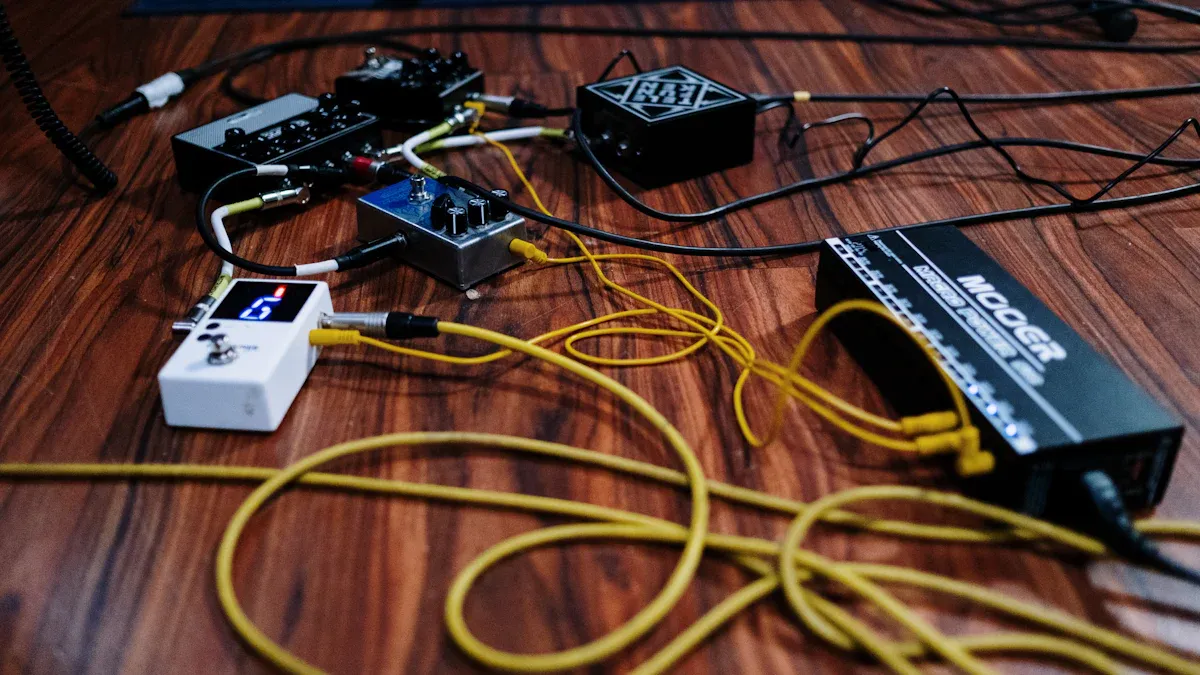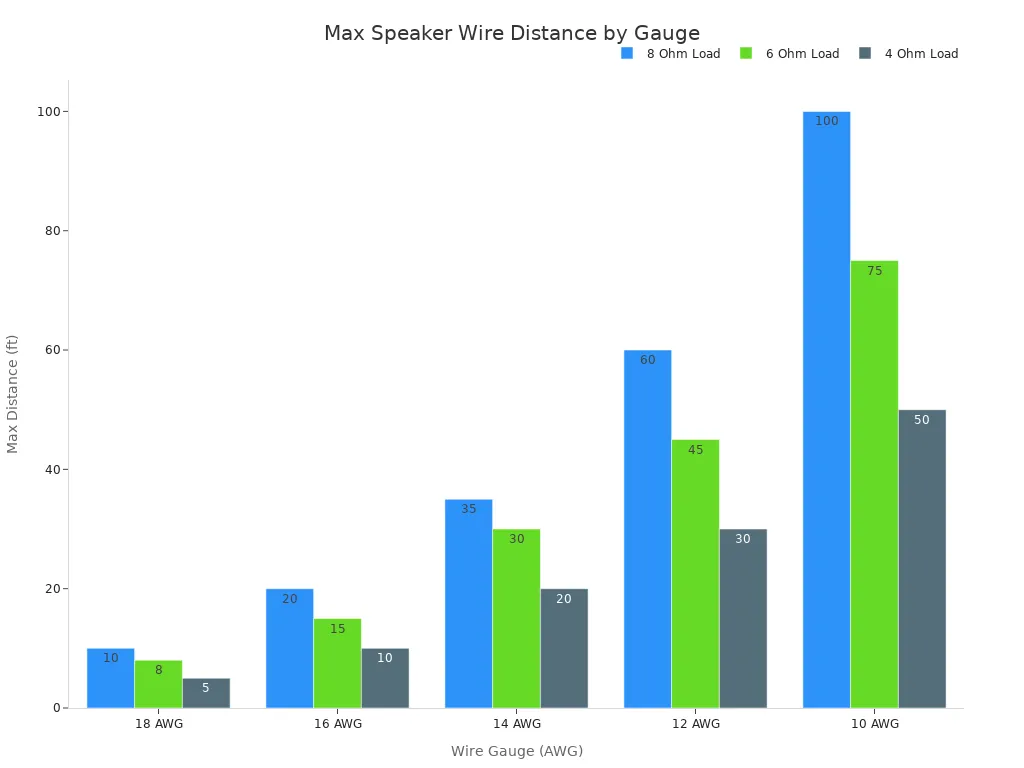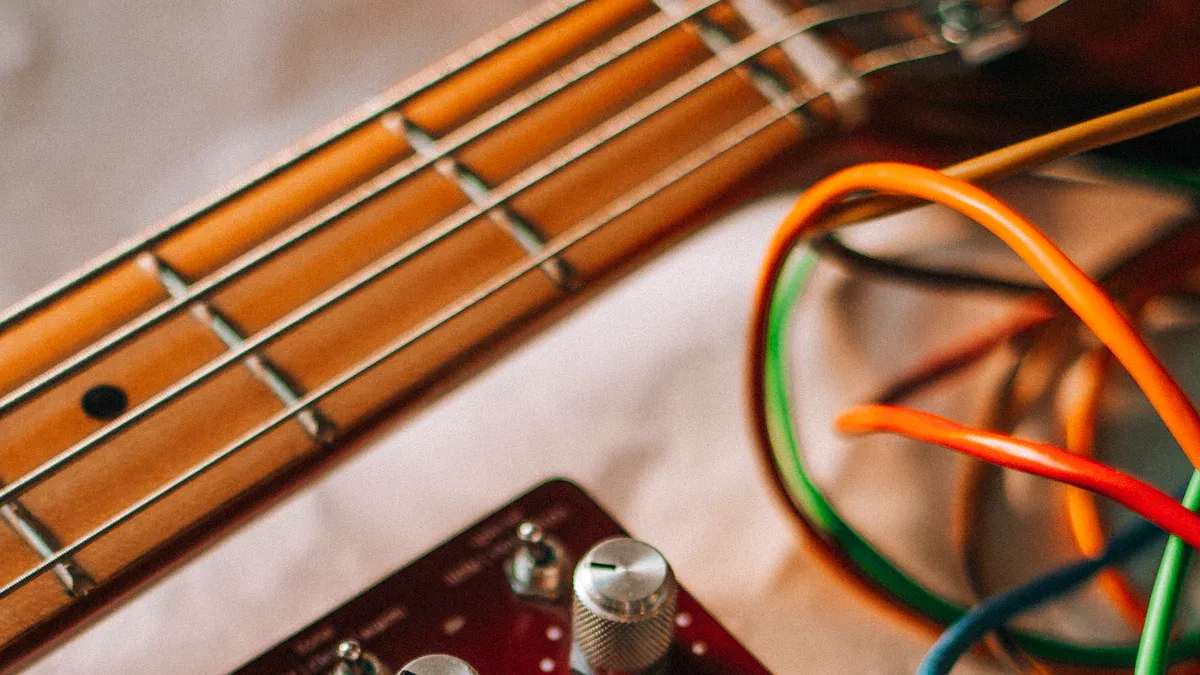Views: 0 Author: Site Editor Publish Time: 2025-07-21 Origin: Site








You often see 18, 16, or 14 gauge wire used for connecting a speaker to an amplifier. For car audio, 14 gauge speaker wire stands out as a top choice, especially if your system uses an amplifier or higher power. Many factory setups use 16 or 18 gauge, which can work for low-power speakers but may limit your sound quality as power increases. Choosing the right speaker wire gauge ensures your speaker receives full power and crisp sound. Copper wire plays a big role, too. Distance matters—longer runs need thicker wire. A quick-reference table helps you match gauge, distance, and power. Ask yourself: how much wire do you need for your speakers? The right speaker wire size keeps your system safe and your music clear.
Choose thicker speaker wire (lower AWG number) for longer distances or higher power to keep sound clear and avoid power loss.
Match your wire gauge to your speaker's impedance; lower impedance needs thicker wire to handle more current safely.
Use copper wire for the best sound quality and durability; if using cheaper copper-clad aluminum (CCA), pick a thicker gauge to compensate.
Measure your wire length carefully before buying and add extra for bends to avoid running short and ensure proper connections.
Avoid using wire that is too thin, as it can cause poor sound, power loss, or damage to your amplifier and speakers.

When you choose a speaker wire gauge, you want to match your system's needs for distance, power, and speaker type. The American Wire Gauge (AWG) system measures wire thickness. Lower AWG numbers mean thicker wire. Thicker wire carries more current and reduces signal loss, especially over long distances. You see this principle in every wire gauge chart and wire size chart.
Here are the most common speaker wire gauges and their typical uses:
18 AWG: Works for short runs (under 10 feet) and low-power speakers. You might use it for small bookshelf speakers or rear surrounds in a compact room.
16 AWG: Fits most home audio setups. It handles standard 8-ohm speakers at distances up to 20 feet. Many people use it for front and surround speakers in home theaters.
14 AWG: Handles higher power or longer runs. It suits distances up to 35 feet for 8-ohm speakers. You want this gauge for car audio, subwoofers, or low-impedance speakers.
12 AWG: Best for very long runs, high-power systems, or professional setups. It works well for distances up to 60 feet and for 4-ohm speakers.
Tip: Thicker wire (lower AWG) helps prevent power loss and keeps your music sounding clear, especially if you have long cable runs or low-impedance speakers.
You can see wire gauge explained in every wire gauge chart. Lower numbers mean thicker wire, which supports more power and longer distances. If you want to optimize your system, use a speaker wire calculator to find the best wire gauge for your setup.
You can use this quick-reference table to match speaker wire gauge, distance, and speaker impedance. This table helps you pick the right wire for your speakers and amplifier, so you get the best sound and avoid overheating.
Speaker Impedance | 8 Ohm Load (max distance ft) | 6 Ohm Load (max distance ft) | 4 Ohm Load (max distance ft) |
|---|---|---|---|
18 AWG | 10 | 8 | 5 |
16 AWG | 20 | 15 | 10 |
14 AWG | 35 | 30 | 20 |
12 AWG | 60 | 45 | 30 |
10 AWG | 100 | 75 | 50 |
This wire gauge chart shows you how thicker wire (lower AWG) lets you run longer cables without losing power. If you use a 4-ohm speaker, you need thicker wire than for an 8-ohm speaker. For most home setups, 16 AWG or 14 AWG works well. For car audio or long runs, 12 AWG gives you extra safety and performance.

Lower AWG wire reduces resistance and keeps your amplifier delivering full power.
Thicker wire preserves high-frequency details and prevents signal loss.
For longer runs, increase wire thickness by two AWG sizes to avoid power loss.
You can use a wire size chart or a speaker wire calculator to double-check your choice. These tools help you balance cost, flexibility, and performance. Always check your wire gauge chart before buying wire for your speakers.

You need to consider both distance and power when picking the right speaker wire gauge. The longer the wire, the more resistance it adds. This resistance can cause your speaker to lose power and sound quality. If you keep your wire length under ten feet, you can use a thinner gauge. Many experts suggest eight feet as a practical length for most setups. When your speakers sit farther from your amplifier, you should use a thicker wire. This helps reduce resistance and keeps your music clear.
If you use a high-power amplifier, you need to pay even more attention to wire gauge. More power means more current flows through the wire. Thin wire can overheat or lose signal if you push too much power through it. For powerful systems or long wire runs, choose a lower AWG number. For example, 12 AWG or 14 AWG works well for long distances or high-power setups. Always match your wire gauge to both the length and the power of your system.
Tip: Shorter wire runs help you save money and keep your sound crisp. Try to keep wire length as short as possible.
Speaker impedance plays a big role in choosing the right wire gauge. Most speakers have an impedance of 4, 8, or 16 ohms. You want to match your amplifier's output to your speaker's impedance for the best power transfer. If you wire multiple speakers together, the total impedance changes. Series wiring adds the impedance values, while parallel wiring lowers it.
Here is how impedance affects your wire choice:
Lower impedance (like 4 ohms) means more current flows through the wire. You need a thicker gauge to handle this current without losing power.
Higher impedance (like 16 ohms) allows you to use thinner wire for the same length.
If you use two 4-ohm speakers in series, you get 8 ohms total. In parallel, two 16-ohm speakers also give you 8 ohms.
Speaker Impedance | Recommended AWG (up to 20 ft) | Recommended AWG (up to 50 ft) |
|---|---|---|
4 ohms | 14 AWG | 12 AWG |
8 ohms | 16 AWG | 14 AWG |
16 ohms | 18 AWG | 16 AWG |
If you want to see wire gauge explained in detail, remember that lower AWG numbers mean thicker wire. Thicker wire helps prevent voltage drop and keeps your speakers performing at their best. Always check your speaker wire gauge chart before making a final choice.
When you choose speaker wire, you often see two main types: copper and copper-clad aluminum (CCA). Copper wire gives you the best performance for your speaker system. It carries current better and keeps resistance low. CCA wire uses an aluminum core with a thin layer of copper. This design makes it lighter and less expensive, but it does not match the electrical performance of pure copper.
You can see the main differences in this table:
Attribute | Copper Speaker Wire | Copper-Clad Aluminum (CCA) Wire |
|---|---|---|
Electrical Conductivity | Superior conductivity, lower resistance | Lower conductivity, higher resistance |
Durability | More durable, resists oxidation, lasts longer | More prone to oxidation, shorter lifespan |
Cost | More expensive | Cheaper |
Flexibility | Heavier, less flexible | Lighter, more flexible, but breaks easier |
Copper wire helps your speaker deliver clear sound, even over long distances. It resists corrosion and lasts for years. CCA wire saves money and works for short runs or budget setups, but you may notice more signal loss, especially if you use a thinner gauge or longer wire.
You want to balance cost and performance when picking speaker wire. Copper wire costs more, but it gives you better sound and reliability. If you use CCA wire, you need to choose a thicker gauge to match the performance of copper. For example, if you use 16 gauge copper wire for your speaker, you should use 14 gauge CCA wire for the same job.
Here are some tips to help you save money without losing quality:
Use copper wire for long runs or high-power speaker systems.
Choose CCA wire for short runs or low-power speakers, but increase the gauge size.
Always check the label to see if the wire is pure copper or CCA.
Avoid very thin wire, even if it saves money. Thin wire increases resistance and hurts sound quality.
Measure your wire runs before buying. Buy only what you need.
Note: Copper wire gives you the best results for any speaker setup. If you use CCA, always go up one gauge size to keep your sound strong.
You make the best choice by matching the right wire material and gauge to your speaker needs. This way, you get great sound and protect your investment.
You want to measure wire length before you buy. Start by planning the path from your amplifier to each speaker. Use a tape measure to follow the route along walls, under carpets, or around furniture. Add a little extra to each measurement for slack and easy connections. This helps you avoid running short. Ask yourself, "how much wire do you need?" Write down each wire length for every speaker. Add the numbers together for the total. You can use a speaker wire calculator to double-check your estimate.
When you choose wire, remember that longer wire runs need thicker gauge. For example, a 16 gauge wire works for short distances, but a 12 gauge wire handles longer runs. Copper wire gives you better performance, especially if you use long wire length. Always check the distance and power for each speaker. This keeps your sound clear and your system safe.
Tip: Measure twice, cut once. Double-check your wire length before making any cuts.
Many people make simple mistakes when choosing speaker wire. Avoid using wire that is too thin for your setup. Thin wire increases resistance and can cause power loss. If you use high power or low impedance speakers, always pick a thicker gauge. Never guess the wire length. Short wire can leave you with exposed connections or stretched wires.
Here is a table to help you decide when to use thicker or thinner wire:
Factor | Recommendation for Wire Gauge (Thickness) | Reason/Effect |
|---|---|---|
Distance | Use thicker wire (lower gauge number) for longer distances | Thicker wire has lower resistance, reducing power loss over long runs |
Amplifier Power | Use thicker wire for high power (250+ watts) amplifiers | Allows more current flow, prevents power loss, and protects amplifier |
Speaker Impedance | Use thicker wire for low impedance speakers (~4 ohms) | Lower impedance draws more current, requiring thicker wire to handle it efficiently |
Short Distances & Low Power | Thinner wire (higher gauge number) is adequate | Less current and shorter runs mean resistance and power loss are minimal |
Wire Too Thin for Current | Avoid using wire too thin for the current load | Thin wire may melt and damage amplifier |
Maximum Recommended Length | About 15 meters; beyond this, thicker wire gauges are necessary | Longer wires increase resistance and reduce sound quality |
Impact of Thicker Wire | No negative effect on sound quality but more expensive, heavier, and less flexible | Thicker wire improves efficiency but may be less convenient |
You also want to use the right tools and accessories for secure connections. Try banana plugs, spade connectors, or pin connectors for easy and safe speaker wire connections. Use cable ties and clips to keep wire neat. Choose copper wire for the best results. Always check the label for gauge and material.
Note: Thicker wire costs more and feels heavier, but it protects your amplifier and keeps your music strong.
Choosing the right speaker wire gauge keeps your system safe and your music clear. You want to match the copper wire to your speaker, gauge, length, and power needs. Use this checklist:
Check your amplifier's power output.
Find your speaker's impedance.
Measure the wire length, adding extra for bends.
Pick copper wire for best results.
Use a gauge chart to match speaker, length, and power.
You get the best sound when you balance copper quality, wire gauge, length, and your budget.
If you use wire that is too thin, your speaker may lose power and sound dull. Thick wire helps your speaker get full power. Always match the wire gauge to your speaker's needs for the best results.
You can use different gauges, but it is best to keep all speaker wires the same size. This helps each speaker get the same power and sound quality. Mixing gauges may cause one speaker to sound louder or softer.
Yes, long wires add resistance. This can make your speaker lose volume and detail. Keep wire runs as short as possible. For long distances, use thicker wire to help your speaker perform better.
Most people do not need expensive wire. Good copper wire gives your speaker clear sound. You do not need to buy special brands. Focus on the right gauge and material for your speaker setup.
You can use regular electrical wire, but it may not fit speaker terminals well. Speaker wire is flexible and easy to connect. It helps your speaker work safely and sound its best.